The golden age of advertising is truly well behind us, but we still live in a world swarmed by commercial messaging. No matter where we’re going, there’s always something--or someone--trying to grab our attention. It’s a Mad Men world minus anything that can conceivably offend someone--and that's boring. Let's look back and be surprised at how far some older ads went to grab attention. None of this would fly today.
Love’s Baby Soft; 1970s
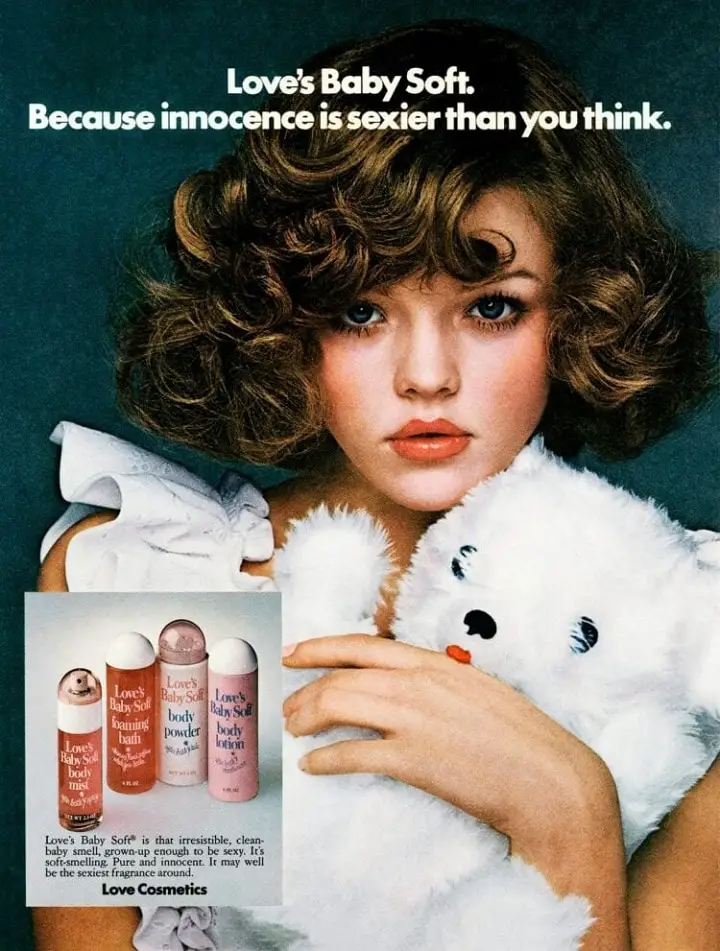
What were they thinking? Apparently not much. Love’s Baby Soft Cosmetics decided to show a picture of a (very) young girl wearing mature makeup while holding a teddy bear with an image of phallus-shaped perfume bottles. What was meant to capture a scent of “innocence” is turned into a pedophiliac’s field dream and a parent’s worst nightmare.
Below, the ad captures the audience with “Love’s Baby Soft is that irresistible, clean-baby smell, grown-up enough to be sexy. It’s soft-smelling. Pure and innocent. It may well be the sexiest fragrance around.” How is a “clean-baby smell” sexy? Is it even legal to put those two words together?
Skinless wieners; 1940s

Okay, someone had to ugly snort at this ad. I mean, who gave permission to advertise wieners, or in this case, Skinless wieners? A company called Viskase was big on skinless hot dogs. They advertised that their product not only tasted better, but argued that it retained more flavor.
How do the “skinless” wieners work? It was a cheaper option compared to the edible casing surrounding the hot dog since the cellulose wrapper around the Skinless wieners was inedible. Once you cook the hot dogs, you’re supposed to peel off the plastic and eat the sausage. Not exactly eco-friendly, and probably doing some long-term damage to the consumer’s health. Just an odd sausage brand that deserves to be in the butt of every joke.
Pears’ Soap; 1899
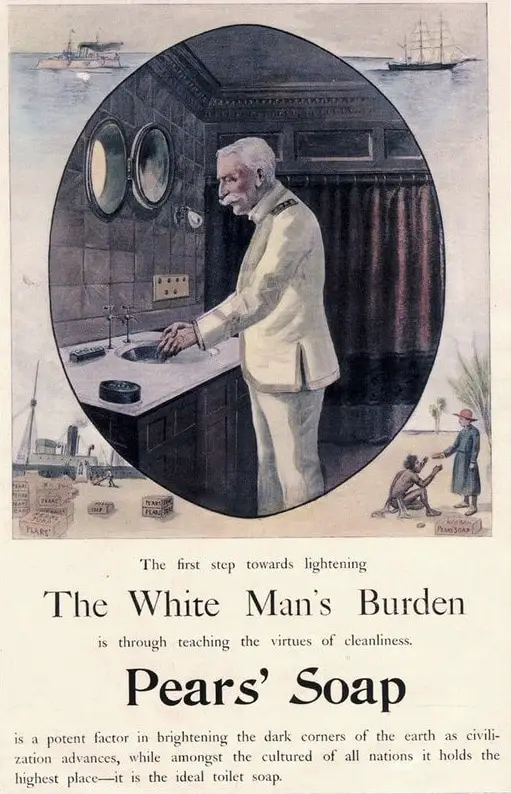
Taking a short break from the drug ads, here’s a popular soap brand that decided to perform their civic duty by tackling third-world uncleanliness. In this ad, you can clearly see a black male at the bottom right groveling in thanks for receiving a bar of soap. This was during the time of the English rule when Queen Victoria Sharpied most of the world. This ad in particular communicated, “…a potent factor in brightening the dark corners of the earth as civilization advances, while amongst the cultured of all nations it holds the highest place — it is the ideal toilet soap.”
Cocaine toothache drops; 1885

Before you start rolling your eyes and guffawing at this ad, let’s talk about cocaine in the 1880s. Before it was a big, bad drug, and before Tony Montana powdered his nose with a line of that powdered magic, cocaine was a popular ingredient in alcoholic beverages in the mid-19th-century, the most popular being coca wine which eventually evolved to Coca-Cola. It wasn’t until the 1880s that doctors found a way to use cocaine for medicinal purposes. By the late 19th century, cocaine was a modern ingredient in any pain relieving tonic, including toothache drops.
Tetley’s Teas; late 19th-century
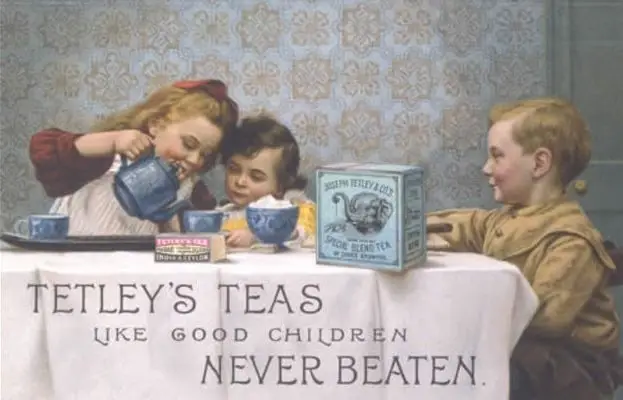
There’s nothing better than a steeped cup of morning tea with a spoonful of child abuse on the side. There’s no need for sugar lumps when you can put lumps on children. Physically disciplining your children was the norm until about the 1990s. Any way, we’ll take honey with our tea, thank you. Maybe the bitter taste will be easier to swallow.
Mrs. Winslow’s Soothing Syrup; 1860s
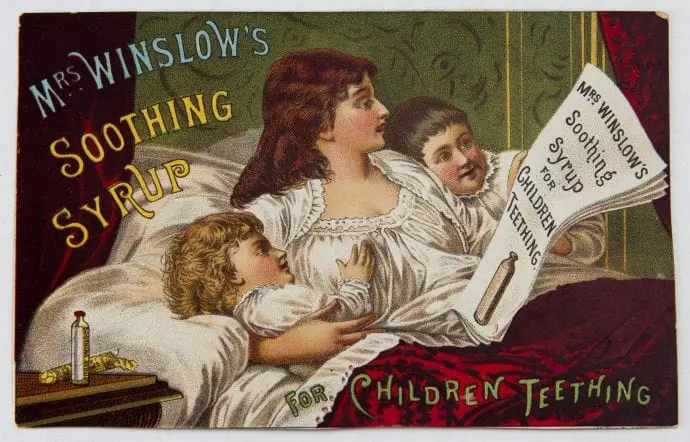
Yeah, just sprinkle a little morphine wine in your infant’s mouth and he’ll be right as rain, giggling and kicking as if there wasn’t a care in the world. Your child will be high as a kite, but hey, at least they’ll stop crying. If you thought cocaine in toothache drops were bad, how about opiates?
Back in the mid-1800s, there wasn’t a FDA-approved sticker on medical or tonic labels. That didn’t happen until the turn of the century at least. Up to that point, mothers relied on word alone and hoped for the best. Ingredients for Mrs. Winslow’s Soothing Syrup was no surprise and held a well-guarded secret when it came to their ingredients. When the Pure Food and Drug Act of 1906 forced the company to list its ingredients, the syrup didn’t last long after. Soothing syrup anyone?
Iver Johnson Revolver; 1904
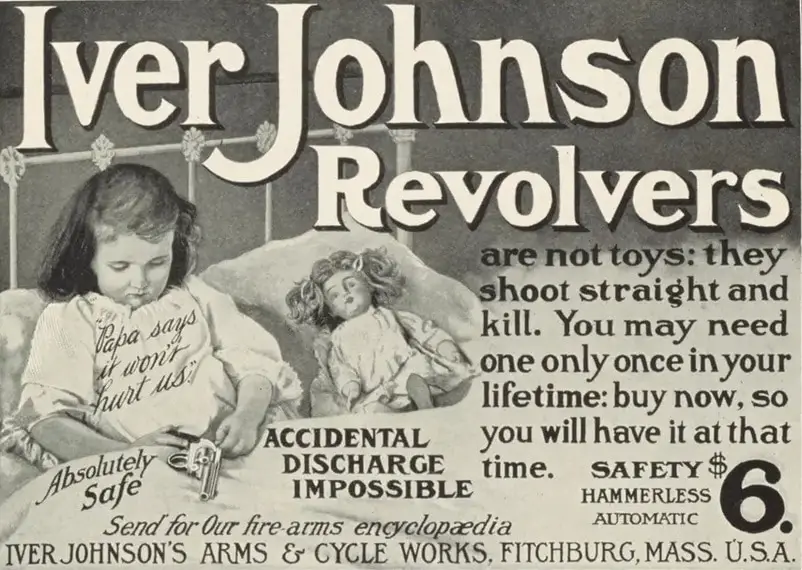
There is no guarantee that this is the last vintage ad featuring a child, but it is guaranteed to be the last vintage ad featuring a child before the 1920s. Iver Johnson Revolvers was trying to convince their consumers that their revolvers were safe, yet able to point and shoot to kill. Iver Johnson’s Arms & Cycle Works was trying to come up with a gun that didn’t misfire when jostled or dropped and came up with the hammerless revolver. The design had a manual safety on the trigger and they marketed the revolver by putting it in the hands of a toddler. With or without the hammer, it’s disturbing to see a child playing with any kind of firearm, accidental discharge impossible or not.
The Saturday Evening Post; 1940s
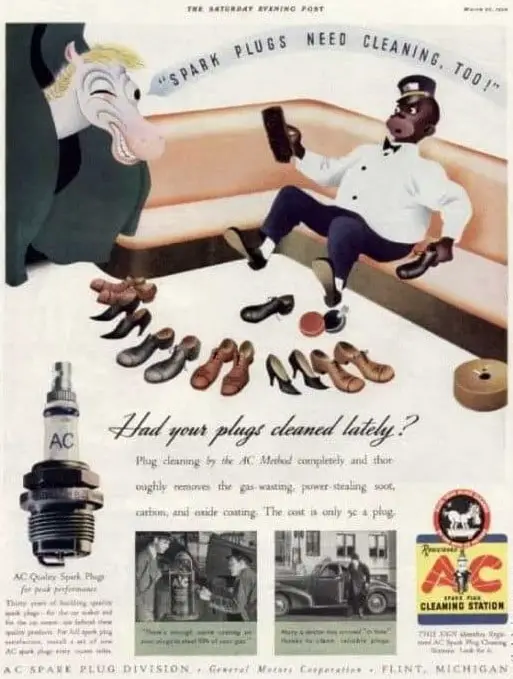
This is a spark plug advertisement from the Saturday Evening Post, an Indiana-based paper founded in 1821. We see a black male shining shoes and being told to clean a white horse’s spark plugs. The black male appears dim-witted, confused, and overwhelmed, but willing to perform his orders. The Homer Simpson archetype is in today's advertising world the exclusive domain of white men, which makes this vintage ad extra potent in unsettling modern audiences.
Pitney-Bowes postage meter; 1947

Married couples always joke around when wanting to strangle or kill each other, but for a clerk and a customer? Unheard of. The ad is for a postage meter, an automatic instrument meant to show evidence that your mail has been sent and delivered. We’re going to assume that once upon a time in 1947, the machine was available for consumer purchase.
In this particular ad, a salesman is trying to convince a stubborn patron to give the product a chance. The patron — a woman — is described as difficult, unmoving, and childish, and when she finally gives it a shot, she returns only to brightly exclaim that it was indeed a great machine. A classic tale of a difficult customer, but one that sends a message that women don’t know what they really want, which is totally not true!
Schlitz; 1952
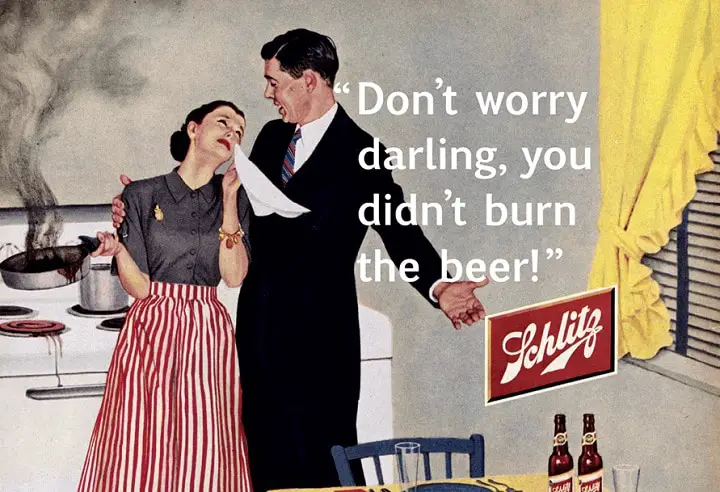
Can’t cook? That’s ok, honey, we have beer! The 50s was a gold mine when it came to domestic ads. Known as the “age of conformity,” this was a pinnacle time for advertisers to cater to the nuclear family dynamic: the man of the house is the problem-solver, the provider, and one who enforced discipline; the women is the nurturer who succumbs easily to her emotions.
Stokely’s Van Camp’s pork and beans; 1952
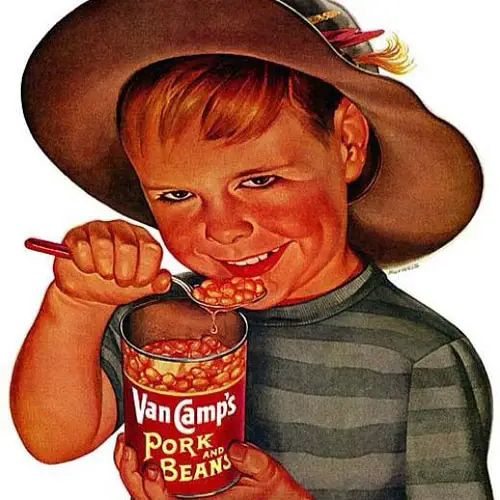
Okay, so there’s nothing wrong with the ad in general, but something is really wrong with this kid’s expression. He looks like he’s plotting to murder you in your sleep while slurping a can of pork and beans, “Hey, you want to know what happens to folks who don’t buy a can of Stokely’s Van Camp’s pork and beans?…accidents happen. They can be so common, especially in a decade where people left their front door unlocked.”
Okay, we went too far, but in fairness, the artist crossed the line when he drew up this illustration. It’s enough to stifle a shiver when you next walk down the canned food aisle at your grocery store. Plus, anyone else getting a Alex vibe, a la A Clockwork Orange?
Alcoa HyTop; 1953
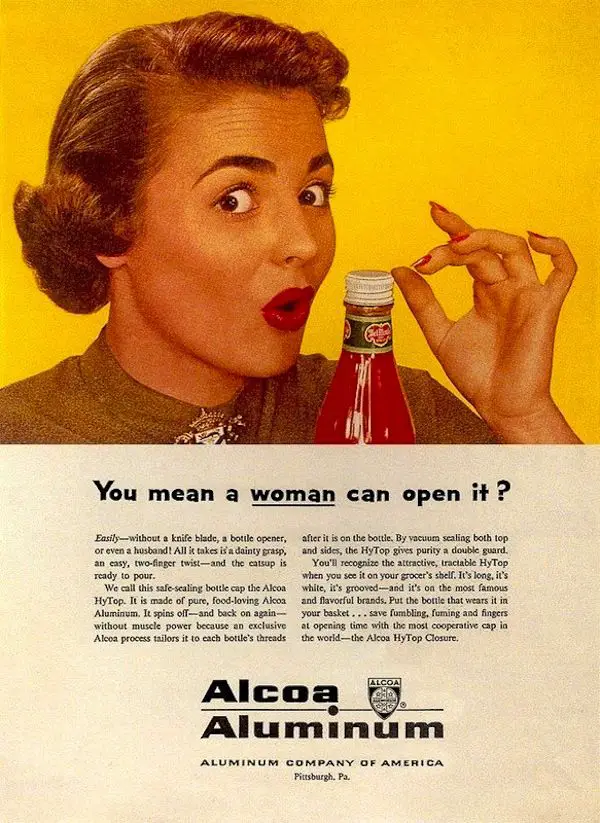
"All it takes is a dainty grasp, an easy two finger twist — and the catsup is ready to pour.” So easy even a woman can open it! Considerate.
7-Up; 1955

Run in the days when soda companies didn’t consider the health repercussions of consuming soft drinks, this is an ad that would make any modern parent cringe. The ad shows a happy 11-month-old boy enjoying what every adult takes pleasure in, a nice cold 7-Up. The ad in question considers their product “wholesome” and boasts that, unlike other soft drinks, 7-Up lists all its ingredients and recommends feeding the sugary drink in a bottle of milk. Little did parents of America know that a bottle of 7-Up contained the equivalent of 10 spoonfuls of sugar and was high with caffeine and can siphon calcium from a baby’s bones. Got fizz?
Chlorinol Soda Bleaching; 1920s?
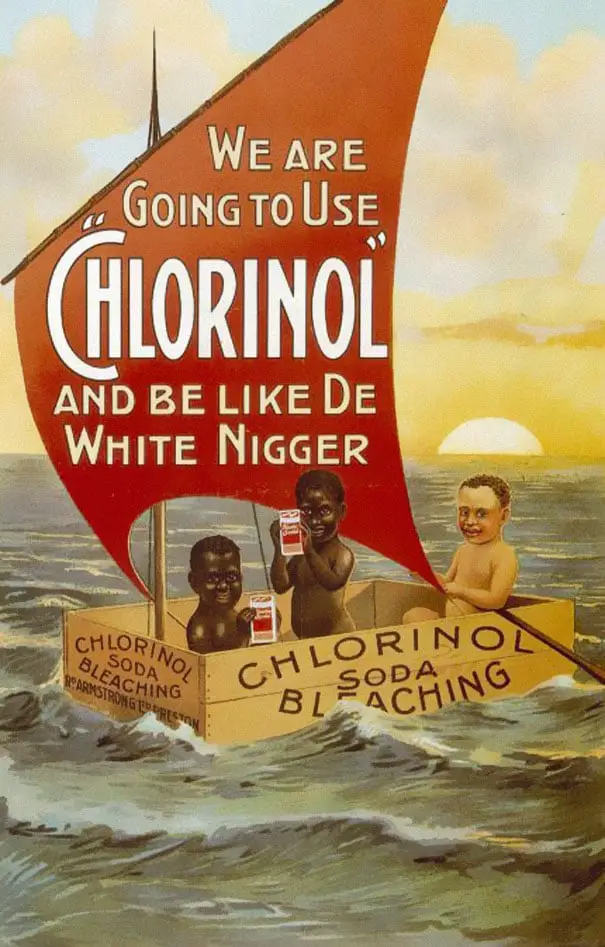
The product is so effective it can turn black boys white!
Zippo Slim-Lighter; 1957
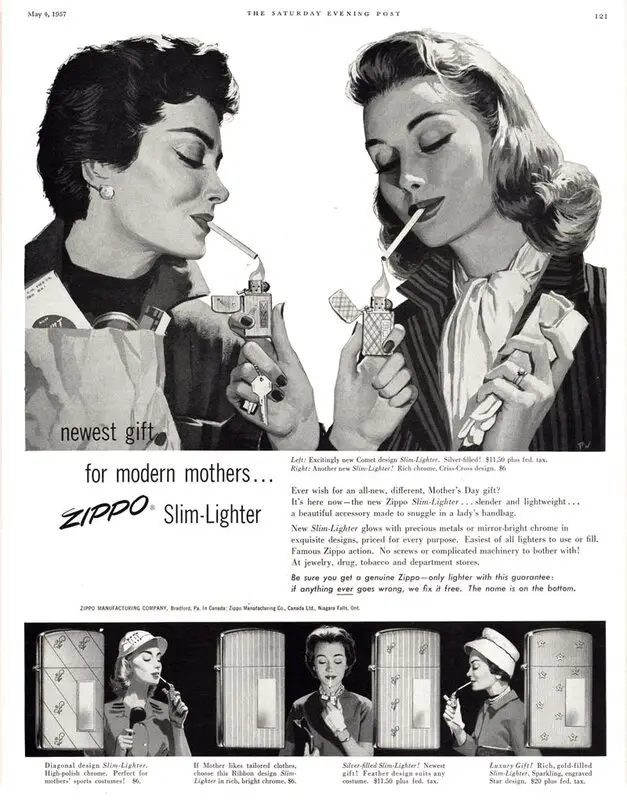
Know a new mother? Give her the gift of cigarette smoking with Zippo Slim-Lighter!
Smoking a cigarette wasn’t just cool and glamorous during the mid-century, it was a social norm. Everyone who was anyone smoked — even your mother. In 50s Hollywood, famous actors like Jimmy Dean, Audrey Hepburn, and Cary Grant ironically puffed a cigarette on screen, giving cigarette smoking the appearance of a class to the contemporary American. This ad was ridding on that fast horse until 1964, when US Surgeon General Luther Terry linked smoking to lung cancer. After his fifteen-page report, smoking fell out of fashion, and tobacco companies scrambled trying to find new ways to advertise their cigarettes.
Chase and Sanborn Coffee; 1950s
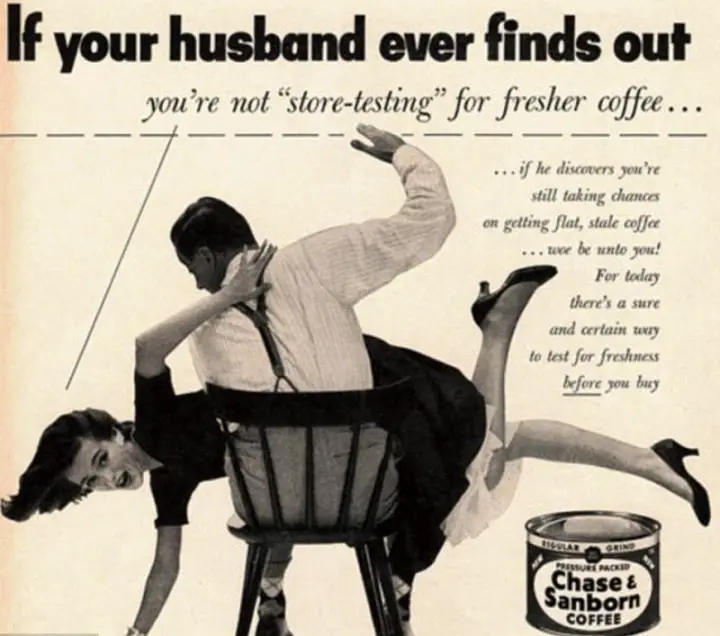
A woman is being spanked by her presumed husband because she didn’t check whether the coffee she bought was stale, as was the custom.
Merito rum; 1950s
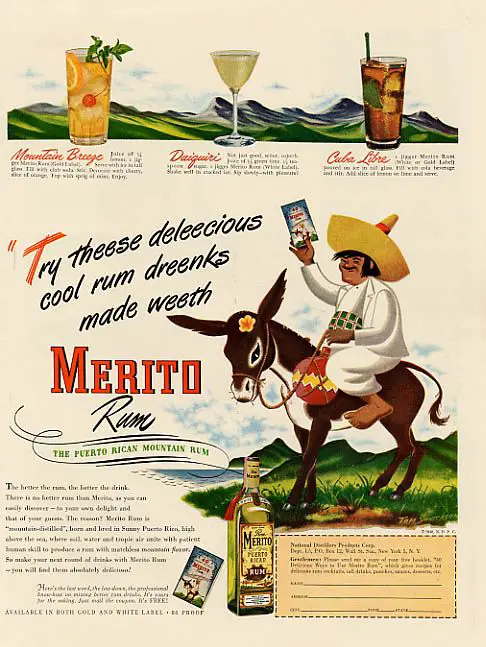
This ad had all of the stereotypes, including the language! "Try theese deleecious cool rum dreenks made weeth Merito Rum the Puerto Rican Mountain Rum."
Van Heusen ties; 1950s
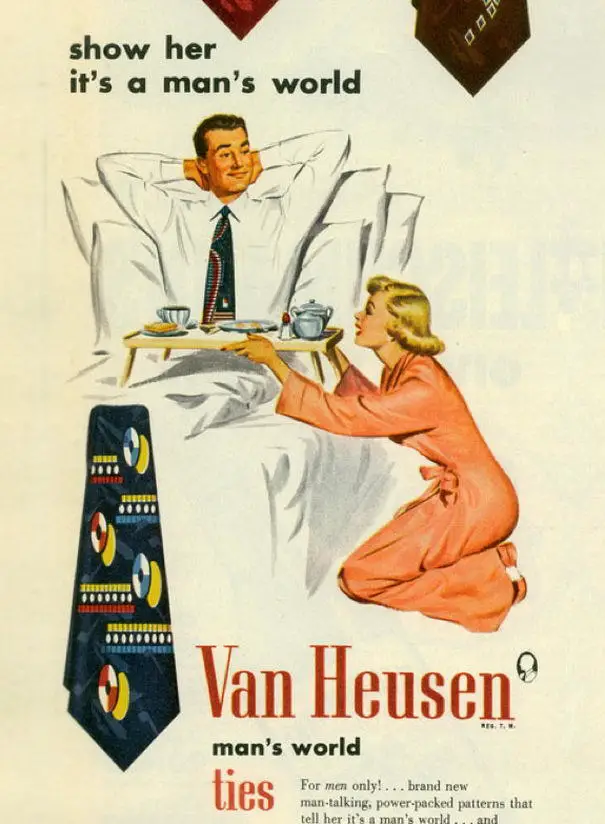
The housewife depicted in the illustration is in a robe and on her knees, while she’s dutifully serving her husband (fashioning a Van Heusen tie) with a wholesome breakfast gingerly placed on his lap. Above them are the words "show her it’s a man’s world," and below the ad continues with "For men only!…brand new, man-talking, power-packed patterns that tell her it’s a man’s world…and make her happy it is!"
Mr. Leggs; 1960s

"Though she was a tiger lady, our hero didn’t have to fire a shot to floor her. After one look at his Mr. Leggs slacks, she was ready to have him walk all over her."
What’s more unsettling is that her expression looks glaring and miserable and it leaves the reader to question whether the ad was truly trying to sell slacks and if so, how does it connect to the consumer? Is it a clever euphemism for "lady killer?" It wouldn't fly today, that's for sure.
Dolce & Gabanna; 2007

The age of actually offensive advertisements are behind us, but every so often we get a curveball. In 2007 Dolce & Gabanna printed their haute couture line ad. The image depicts four unsmiling men, one of which is pinning down a lone woman with her hands above her. This goes well beyond the saying "sex sells" and dives into something else.
Eight years later, Dolce & Gabbana received even more flak about the photo when the designers answered in an interview that children born of IVF are no more than "children of chemistry, synthetic children. Uteruses for rent, semen chosen from a catalog." Their comments royally pissed off many, including singer and songwriter Sir Elton John who swore to never wear Dolce & Gabbana ever again.
Shake Weight; 2010
Remember when you first saw the Shake Weight? Wish you never had? The “Seen on TV” product created a commercial uproar when the promise of having guns as lethal as Michelle Obama’s arms (we all have that Michelle Obama arm envy, let’s be honest) became plausible. All at once, the Shake Weight became an iconic workout tool and beloved sexual innuendo that’s made its mark in most entertainment media outlets such as SNL and The Ellen DeGeneres show. Though it’s not obscene to look at, it is one of those items you can’t help but to shake your head at and flip to the next channel.


